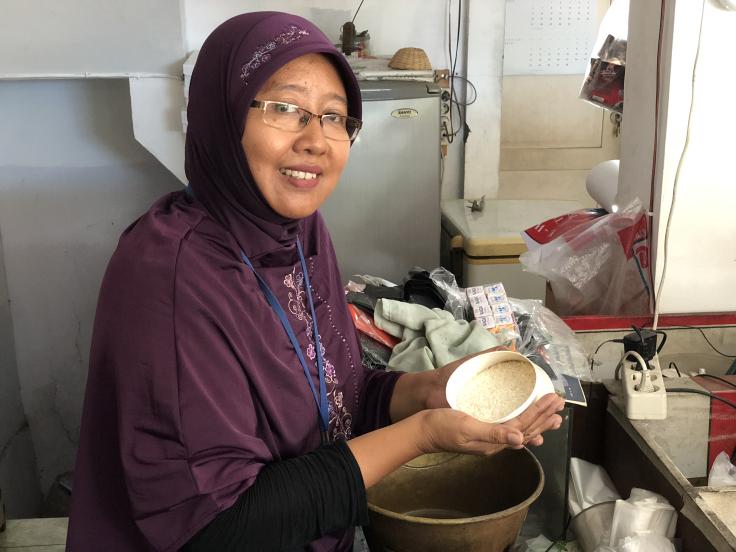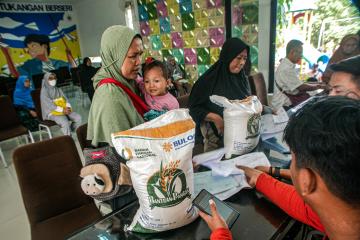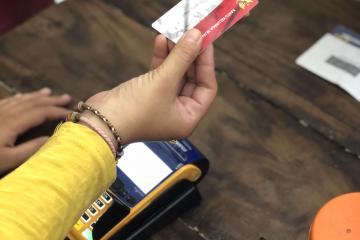
Providing vulnerable households with accurate, timely information about the benefits they’re eligible for can help them better access those benefits and improve government efficiency.
Providing information to households about the benefits they’re eligible for can be a highly cost-effective way to improve service delivery and reduce inefficiency. Sharing information through official channels, like low-cost benefit identification cards, helps empower people to access the benefits they’re entitled to—especially in contexts where there may be inefficiencies or instances of corruption in the benefit system.
Rapid evaluations of new innovations can help governments guide program adaptation and scale. Iterative research can provide quick insights on the effectiveness of new program features and improve delivery at scale. An evaluation and subsequent policy reform in Indonesia provides a model for other low- and middle-income governments seeking to improve delivery of public services.
Inefficiencies and gaps in service delivery can prevent government-run social programs from reaching their poorest citizens. In Indonesia’s flagship food aid program, known at the time as Raskin, subsidized rice meant to feed vulnerable families was not reaching its intended recipients—and when it did, they were paying too-high prices. The government suspected that misappropriation by middlemen was to blame, meaning a large part of Raskin’s US $1.5 billion annual budget was not reaching the people it was intended for.
Informing households about the benefits they were entitled to helped empower them to access those benefits. Giving households identification cards that included their eligibility status, and the amount of benefits they were eligible for, led families to purchase 24 percent more subsidized rice at lower prices. Recipients had more bargaining power: Local officials no longer had a monopoly on eligibility information, so with their ID cards in hand, recipients were empowered to request their full ration of rice at the agreed upon price.
Government-researcher partnerships can enable quick innovation to improve service delivery and increase government efficiency. Before settling on the ID cards as the solution, the government worked closely with researchers to test different approaches. By aligning rapid research with the government’s urgent questions, the results helped shape consequential policy decisions. After seeing the impact of the ID cards, the Indonesian government scaled up benefit ID cards to over 15 million households across the country, reaching over 65 million people in 2013.
Continued testing and iteration based on new data and technology is essential to maximize government efficiency. Since 2013 the government has continued to work with J-PAL researchers to innovate, rigorously evaluate, and further improve access to these benefits. Following the ID cards scale-up, the government pivoted to a digital strategy and tested the effectiveness of an electronic voucher system (essentially a pre-filled debit card). E-vouchers helped even more families access the benefit program, causing poverty to fall by 20 percent among the poorest households, and reduced the logistical burden and administrative costs of the program. These research results provided evidence for the government to scale up the program to 18.8 million households, and to move forward with digitization of Indonesia’s broader social protection system.
Cost and design considerations
Information interventions can be a highly cost-effective way to empower citizens to access their benefits. After just two months, the benefits of the cards outweighed the costs. After eighteen months, the estimated increase in benefits that households received by purchasing more rice at lower prices was over seven times the cost of the ID card program. Eligible beneficiaries received 24 percent more rice for the cost of US $1 per household for the ID cards.
Testing different variations of information delivery helped identify the best approach. Communities were randomly assigned to receive different versions of ID cards or no cards at all, and to receive variations such as sharing basic eligibility information, inclusion of official rice prices, public dissemination of eligibility lists, and targeting only the lowest-income households. The evaluation found that including official prices, and public dissemination to increase transparency, helped maximize impact; this informed the future scale-up.
Program costs were low for ID cards, and even lower for electronic vouchers. The administrative costs of the ID card program corresponded to about 4 percent of the benefits disbursed, and costs of the e-vouchers were between 0.7 to 2 percent of the benefits disbursed.
Delivering benefits via electronic vouchers was more efficient and flexible than in-kind rice distribution. E-vouchers helped improve targeting to ensure those most in need had access to the food assistance program, and helped recipients more easily access the full amount of benefits they were entitled to. The in-kind rice distribution program was limited to rice only, but the vouchers enabled more flexible purchases of both rice and eggs, giving families more choice and access to protein-rich food.
There are important tradeoffs between in-kind and electronic benefit delivery. In-kind distribution provides more of a particular type of good, potentially leading recipients to consume more of that good than they would otherwise. In-kind distribution also often requires moving physical goods around warehouses and relies on local staff or volunteers to distribute, whereas e-vouchers can be electronically refilled. Governments using e-vouchers may have more control over whether targeted beneficiaries actually receive their full benefits, since a debit card is more difficult to sub-divide than locally distributed goods.
But e-vouchers raise their own set of logistical challenges: Availability of cell phone signals for debit card machines, challenges with PINs or other authentication, or even challenges in printing and ensuring that the correct debit cards reach the correct households. In states with limited administrative capacity, these differences are important to consider—both in terms of how programs are implemented in practice, and their ultimate impacts on people in need.
Information interventions can be a highly cost-effective way to empower citizens to access their benefits.

“We need to and are committed to showing that our policies actually benefit the poor…The critical ingredient was a partnership with researchers from the start.”
—Sudarno Sumarto, policy adviser, TNP2K, Office of the Vice President of the Republic of Indonesia
Implementing partners
Implementers bring deep local knowledge, technical expertise, and a commitment to evaluation and learning as they bring these programs to life. Partners include the following collaborators (listed in alphabetical order); this list is not exhaustive.
- Mitra Samya
- TNP2K - The National Team for Accelerating Poverty Reduction, the Indonesian Government
These reforms show what’s possible when low- and middle-income country governments empower citizens with information and use rapid, rigorous research to inform policy improvements. While the benefits program has evolved, the Indonesian government has maintained its commitment to partnering with researchers and using evidence to improve programs that reach its poorest citizens in a series of subsequent reforms. The program’s evolution over time provides a compelling example of how LMIC governments can innovate and use research to strengthen social protection.

The role of foreign assistance and philanthropy
The Raskin program research was made possible by the William and Flora Hewlett Foundation’s support to J-PAL’s Governance Initiative and by the Australian government’s support through its Poverty Reduction Support Facility. The Indonesian government needed research results within six months due to the upcoming budget cycle—a rapid timeline for academic research and funding. J-PAL Southeast Asia had worked with the Australian government to set aside funding for high-potential, high-impact research that could be disbursed quickly. The opportunity to evaluate the Raskin program exactly fit the bill of high-potential research, and the Australian government was able to fund the work on a tight timeline.
Discover more from other sources
Poverty Fighters: Abhijit Banerjee and Esther Duflo
IMF Finance & Development Magazine
Photos:
(1) Officers in Pariaman, Indonesia recording data on communities receiving rice aid from the Indonesian government. Credit: Ranahpixel, Shutterstock.com
(2) A local rice agent for the Non-Cash Food Assistance (BPNT) program in East Java, Indonesia. Credit: Ivan Mahardika, J-PAL

